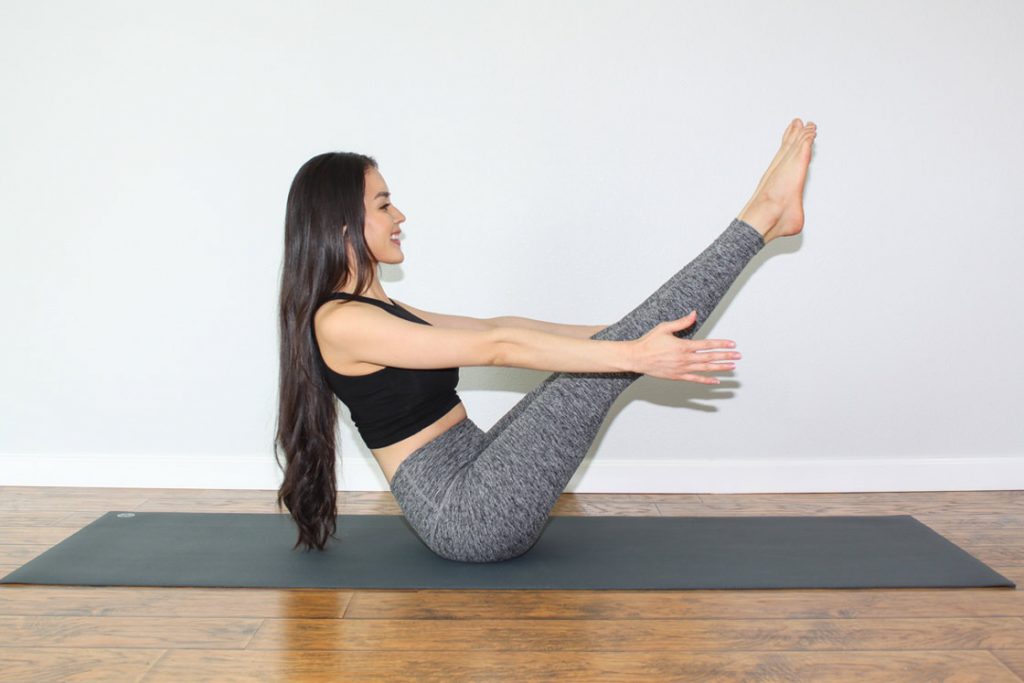
Boat Pose, or Navasana, serves as an excellent core-strengthening pose that targets the muscles of the abdomen and back. This forward-bending posture requires you to balance your entire body weight on your tailbone and sitting bones, making it a challenging but rewarding exercise.
By engaging the core, hips, thighs, and back muscles, Navasana enhances their flexibility and robustness. The body’s posture in Navasana mimics that of a boat (Nava), which is why it is aptly named Boat Pose. During the practice of this pose, the body forms a distinct ‘V’ shape, further emphasizing its resemblance to a boat.
How to Do Boat Pose(Navasana)
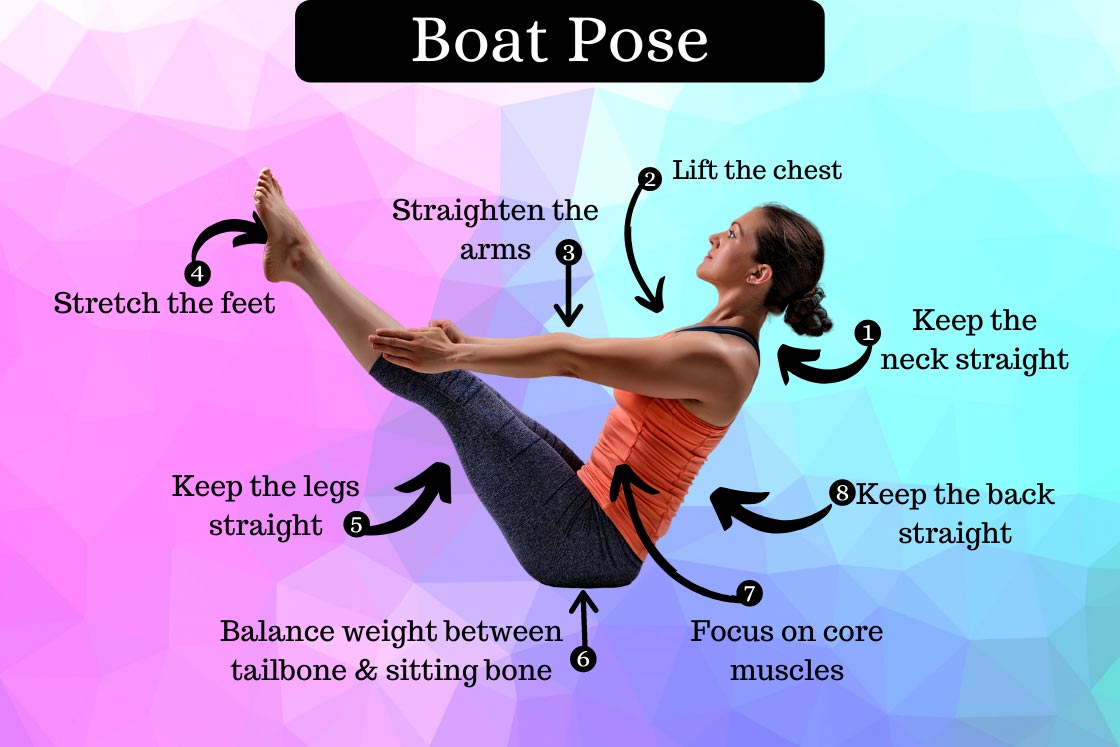
Navasana might look simple in visuals, but is it not as simple as it seems. It requires high core strength and a great focus to balance the body. Here are the steps to perform this pose.
Steps to Perform Boat Pose(Navasana)
- Begin by sitting on the floor with your legs straight and feet flat on the ground, keeping your spine straight.
- Bend your knees and place your feet flat on the floor with your knees pointing upwards. Bring your legs together, with the feet and knees of both legs touching.
- Lean back slightly, draw your shoulders back, and tilt your torso backward. With an exhalation, lift your feet off the floor, balancing your body weight between your tailbone and sitting bones. Keep your shins parallel to the floor, and lift your chest.
- Slowly straighten your legs, creating an angle between 20 to 45 degrees with the floor. Extend your feet, and ensure that your spine remains straight, and your legs don’t spread apart.
- Simultaneously, raise your arms straight at shoulder level, parallel to the floor. Your palms should face towards your thighs, and your fingers should point forwards, creating a “V” shape with your body.
- Take normal breaths and hold this position for approximately 5 to 8 breaths, which is roughly 10 to 20 seconds.
- To release the pose, gently bring your legs down, and you can use your arms for support if needed.
- Come back to a seated position and relax.
Beginner’s Tips
For beginners, performing Boat Pose (Navasana) can be challenging, but there are several modifications and tips to make it more accessible.
- Take the Support of Your Hands: Use your hands for support. Lightly grab your lower thighs with your hands while performing the pose. This will help you maintain balance and proper body posture. As you become more comfortable, try doing the pose without holding your thighs.
- Use Props: Consider using yoga props, such as a yoga strap, to assist you in the beginning. Loop the strap around the soles of your feet and hold it with your hands. This can help you keep your spine, arms, and legs straight, making it easier to maintain the pose.
- Hold for Short Intervals: It’s okay if you can’t hold the pose for an extended period at first. Start by holding the pose for 1-3 breaths, which is approximately 5-15 seconds. As you practice regularly, gradually increase the duration of your hold.
- Partner Assistance: If you’re finding it particularly challenging, consider partnering with someone or seeking help from a yoga teacher. Having a friend or instructor assist you with the pose can provide you with the necessary support and guidance as you work on your Boat Pose.
Precautions and Contraindications
While practicing Navasana, you need to keep the following things in mind.
- Avoid rounding your back; maintain a straight back throughout the pose to keep the focus on your core muscles.
- Perform Navasana slowly and gently; avoid rushing through it. Incorrect execution may lead to discomfort or pain in the core muscles.
- If you have a recent or severe injury in your lower back, hips, thighs, or abdomen, refrain from practicing this asana, as it heavily targets these areas and can have adverse effects on injuries.
- Individuals with low or high blood pressure, as well as those prone to headaches or migraines, should not attempt Boat Pose due to its potential impact on blood pressure and potential discomfort.
- Avoid practicing Boat Pose during the menstrual cycle, as it places pressure on the lower abdomen and lower back, which can be harmful during this time.
Boat Pose (Navasana)Variation
Boat Pose has several variations that add complexity and target different muscle groups. Here are a few Boat Pose variations:
- Half Boat Pose (Ardha Navasana): In this variation, the body creates a partial “V” shape with the bottom on the floor and the knees bent.
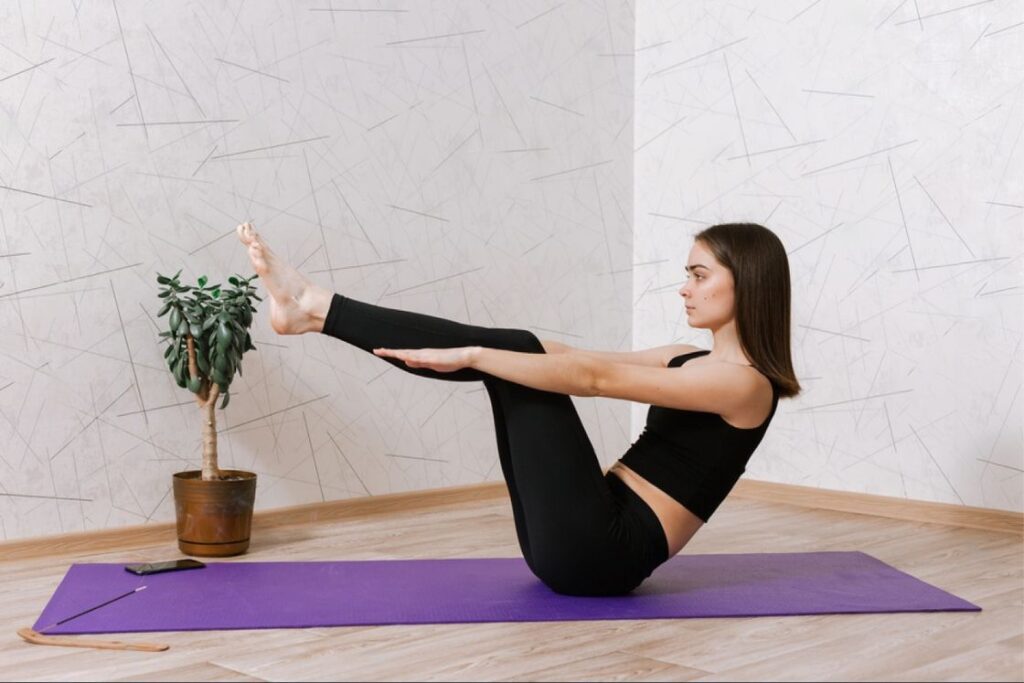
2. Low Boat Pose: In this variation, your legs and upper body are closer to the ground, creating a more intense challenge for the core muscles.
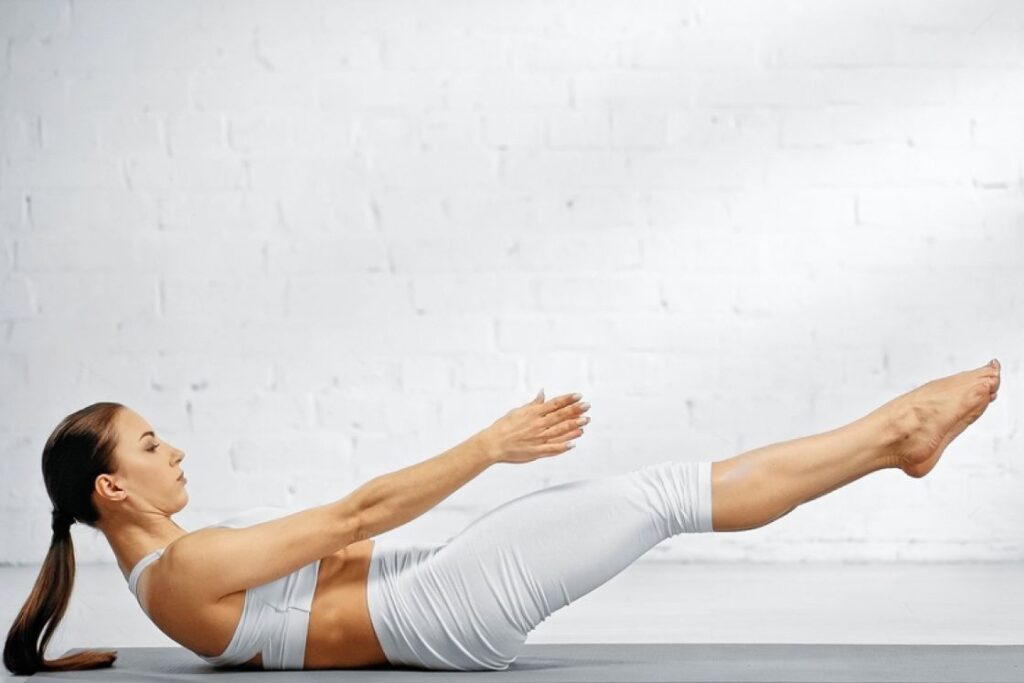
3. Revolved Boat Pose: Revolved Boat Pose, also known as Parivrtta Navasana, is a challenging yoga variation that combines the core-strengthening benefits of Boat Pose with a twist to enhance spinal flexibility and balance. It involves sitting with your legs lifted and twisted to one side, providing a comprehensive workout for the core and oblique muscles while improving your overall body coordination.
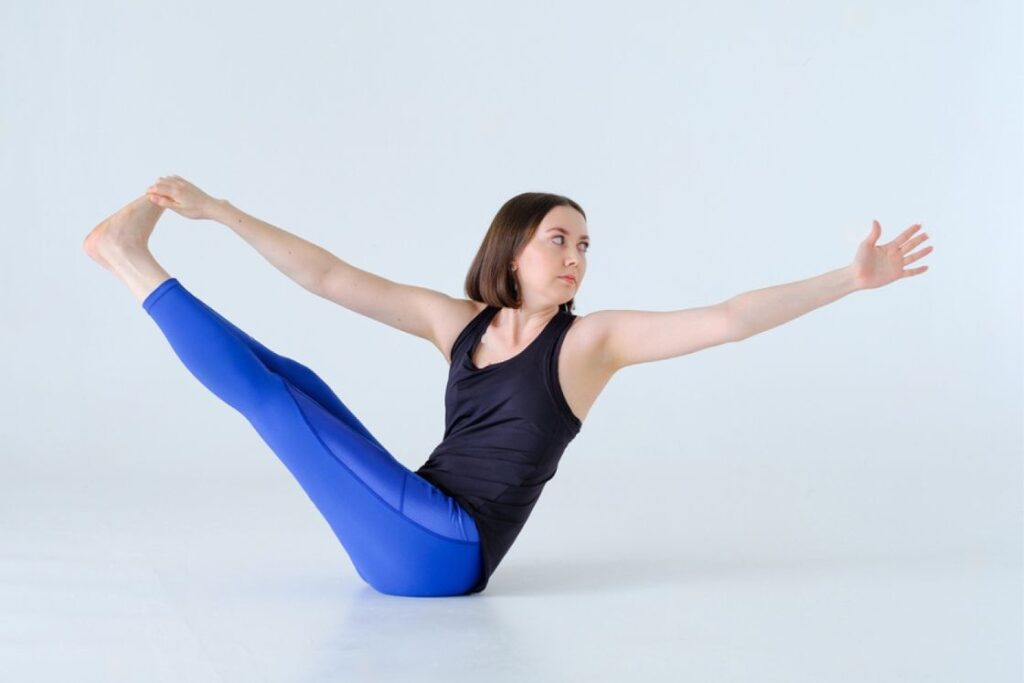
4. Both Big Toe Pose: Both Big Toe Pose, also known as Ubhaya Padangusthasana, is an advanced yoga pose that challenges balance and flexibility. In this pose, you sit with your legs extended, lift both big toes, and hold them, providing a unique stretch and strengthening for the legs and core muscles.
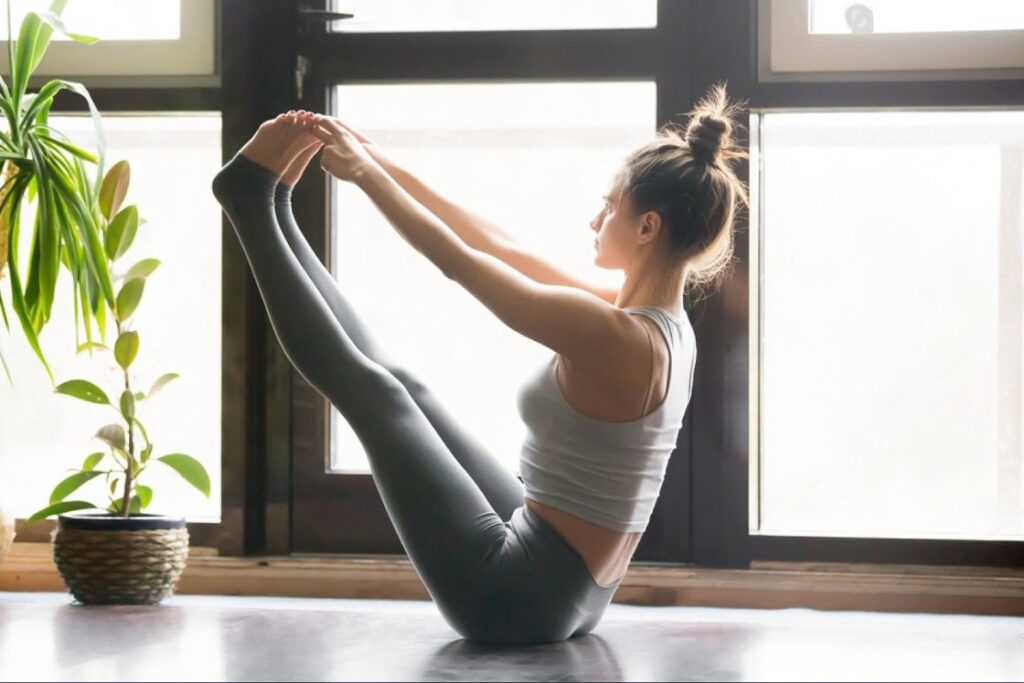
Benefits of Boat Pose
- Enhanced Core Strength
Boat Pose engages the muscles of the core, which includes the abdominals and lower back. Regular practice can significantly increase core strength, helping you achieve a more toned and stable midsection.
2. Abdominal Toning
This pose specifically targets the abdominal muscles, helping to tone and sculpt the muscles of the abdomen. It contributes to a flatter and more defined stomach.
3.Improved Digestive Health
Boat Pose massages the abdominal organs, including the liver, kidneys, and digestive system. This can enhance digestion, increase metabolism, and support overall digestive health.
4. Support for Weight Management
The exercise of the core and back muscles in Navasana can aid in burning excess fat stored in these regions. As a result, it may support weight management and fat loss.
5. Back Health and Flexibility
By placing pressure on the lower back muscles, Boat Pose acts as an exercise for this area. It helps strengthen the lower back, promotes flexibility, and can reduce the risk of back problems.
6. Toning of Hips and Thighs
Navasana also works on the muscles of the hips and thighs, toning and strengthening them. This can enhance the overall shape and strength of the lower body.
7.Stress Reduction and Relaxation
Practicing Boat Pose, like many yoga poses, can help reduce stress and tension. It promotes relaxation, reduces stress in the hip and thigh muscles, and has a calming effect on the mind.
8. Improved Blood Circulation
The physical activity involved in this pose enhances blood circulation throughout the body. Improved circulation can have various health benefits, including mental clarity and increased energy.
FAQs Boat Pose
Boat Pose can be challenging for beginners due to the strength and balance required. It is recommended to start with modifications or variations of the pose and gradually work towards the full expression of Boat Pose as your strength and flexibility improve.
As a beginner, you can start by holding Boat Pose for 10-20 seconds and gradually increase the duration as you become more comfortable with the pose. Advanced practitioners can hold the pose for up to a minute or longer.
It is advisable for pregnant women to consult with their healthcare provider and a certified prenatal yoga instructor before practicing Boat Pose during pregnancy. Modifications may be necessary to ensure safety.
The frequency of practicing Boat Pose depends on your fitness level and goals. You can incorporate it into your yoga routine a few times a week for the best results.
Variations of Boat Pose include Half Boat Pose, Revolved Boat Pose, Low Boat Pose and different arm and leg positioning variations. These provide options to adapt the pose to your fitness level.
Common mistakes include rounding the back, letting the shoulders collapse, and not engaging the core muscles. It’s important to maintain proper form and alignment.
In Boat Pose, focus on deep and controlled breathing. Inhale as you lift your legs and torso, and exhale as you hold the pose. Maintaining a steady breath is essential for balance and stability.




